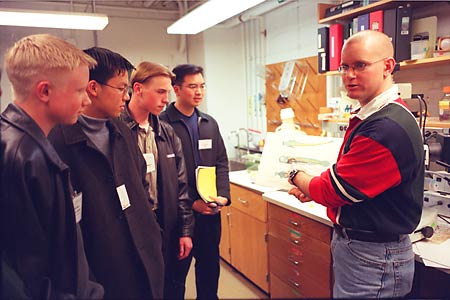Jr. scientists test Harvard’s waters
Lectures, laboratories highlight high school students’ visit

The zebrafish floated on the video screen, the image piped in from a small container whose black and white striped walls rotated, providing motion on which the fish could focus. After a moment, one eye moved, indicating that the fish could see the motion around it.
The fish couldn’t see all the motion in the room, however. Out of the fish’s view was a group of five or six high school students jammed into the Biolabs basement zebrafish facility on Thursday (Feb. 14). The students were among 125 students visiting Harvard after being selected by the American Junior Academy of Science as winners of their state science fairs. The students were in Boston for the annual convention of the American Association for the Advancement of Science, the National Association of Academies of Science, and the American Junior Academy of Science.
“It’s instructive for them to see real research, see their [the researchers’] excitement,” said Karen Shepherd, science teacher at Plano Senior High School in Texas, one of several teachers who accompanied the students to Boston.
The zebrafish the students observed is part of a zebrafish research and breeding facility in the basement of Harvard’s Biological Laboratories. The fish, which are bred to exhibit eye deficiencies and blindness, are used in the study of genetic problems that cause blindness in both fish and humans.
The tour of the zebrafish facility, conducted by postdoctoral researcher Brian Perkins, was just one of 20 going on Thursday morning. Other groups of students visited labs conducting research as diverse as three-dimensional computer imaging of proteins, the interaction of light and matter, and the biology of the worm C. elegans.
The students’ six-hour visit began at 9 a.m. and ran until 3 p.m., beginning and ending with lectures by noted scientists such as Nobel laureate Dudley Herschbach, the Frank B. Baird Jr. Professor of Science, who won the Nobel Prize in Chemistry in 1986, and Lene Hau, Gordon McKay Professor of Applied Physics and Professor of Physics. Hau made worldwide headlines last year when she achieved what was once thought impossible: stopping light and then releasing it at will.
In his morning talk, held in a packed Fairchild Building lecture hall, Herschbach strove to demystify science. He said he had never even taken a chemistry course until his football coach, who wanted him to play football in college, told him he ought to take college prep courses, which included chemistry.
Herschbach said he found chemistry tough, which surprised him, because he had done well easily in all his other courses. So he took some more chemistry in college, eventually leading him to an academic career in chemistry.
Herschbach, who titled his talk “The Impossible Takes a Little Longer,” said he took the title from a saying his father had: “The difficult we do right away, the impossible takes a little longer.” Herschbach said scientists are often doing the impossible, or what was thought impossible not long before.
Though many have the impression that science is hard, Herschbach said it actually is easy, mainly because discoveries are waiting patiently for someone to discover them. No matter how many false starts and wrong turns along the way, scientific mysteries are waiting to be discovered, on a researcher’s second or third or fourth try. Science, he said, is relatively easy compared with business, politics, and sports, all activities in which a change in timing can transform a brilliant move into an idiotic one.
“What you’re trying to find out is waiting patiently for you,” Herschbach said. “You get to try over and over. It’s no wonder that sustained human effort over time keeps finding out new things.”
Another misconception, Herschbach said, is that science is competitive. All scientists, he said, have a healthy respect for those who went before, on whose work their own research depends. While researchers on the cutting edge of certain fields are racing each other to new discoveries, the fact that they have to publish their results in peer-reviewed journals to gain recognition means that even competing researchers have the chance to learn from each other.
Herschbach compared chemistry to an impressionistic painting: If you examine things too closely all you see are individual dabs of paint. If you’re too far away, all you see is a shapeless blur. But from the right distance, a beautiful image appears. He also compared science to music, saying that in order to be good, you don’t have to be able to master every instrument in the orchestra, just the one you can play best. That’s the same with science, he said, and students shouldn’t think that because they’re not doing well in physics, they can’t be a chemist.
“The landscape is enormous. There’s all sorts of domains and your job is to find a place where your temperament and talents resonate and match the needs of that domain,” Herschbach said.
The students appreciated Herschbach’s message – as well as those of other speakers.
Carol Choy, a senior from Plano Senior High School, said she enjoyed the speakers much more than other speakers on science she’d heard before. They were able to boil down complex topics into understandable and interesting talks, Choy said.
“I think it’s been good so far,” Choy said after Herschbach’s and Professor of Molecular and Cellular Biology Andrew Murray’s morning talks. “These two were terrific.”




